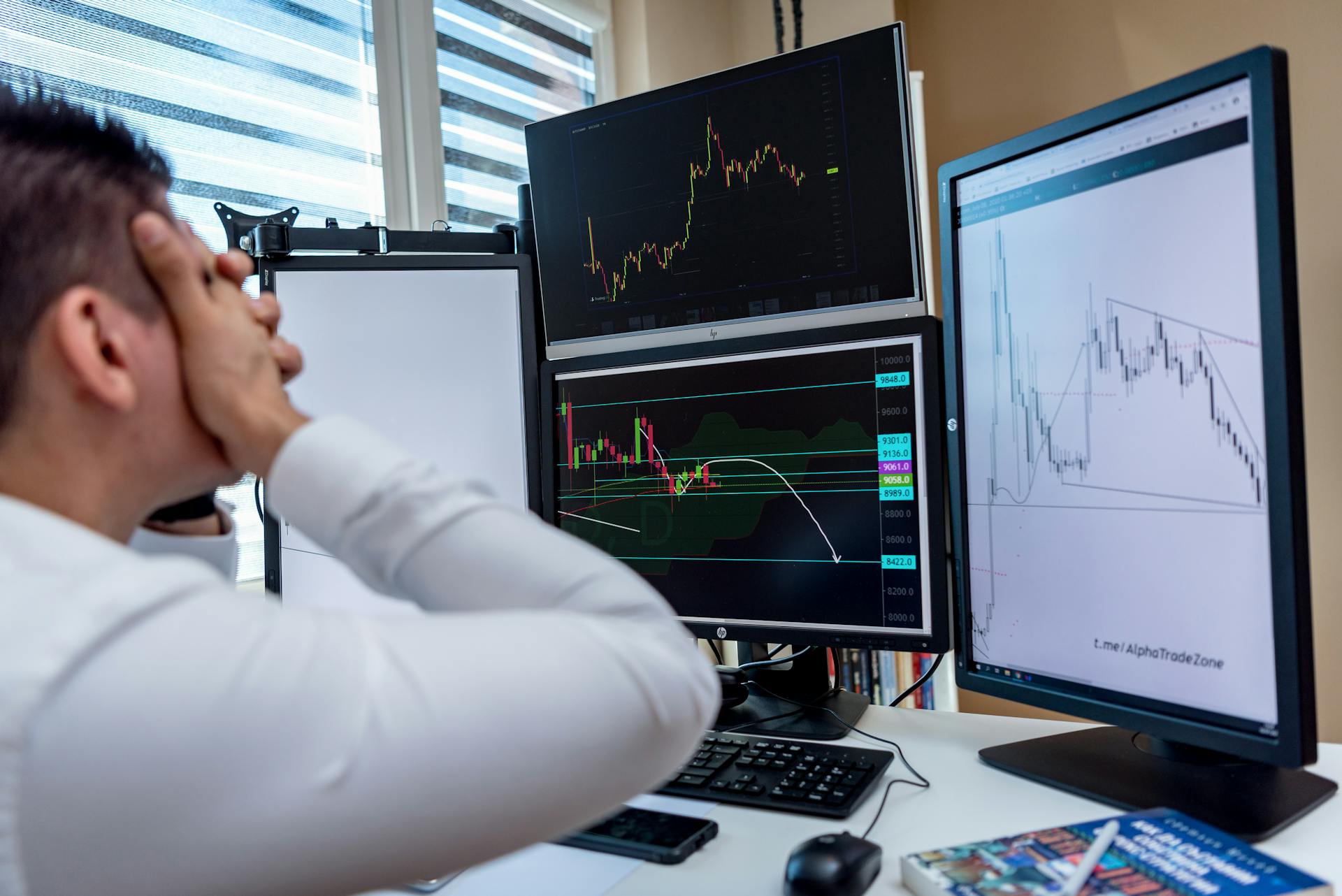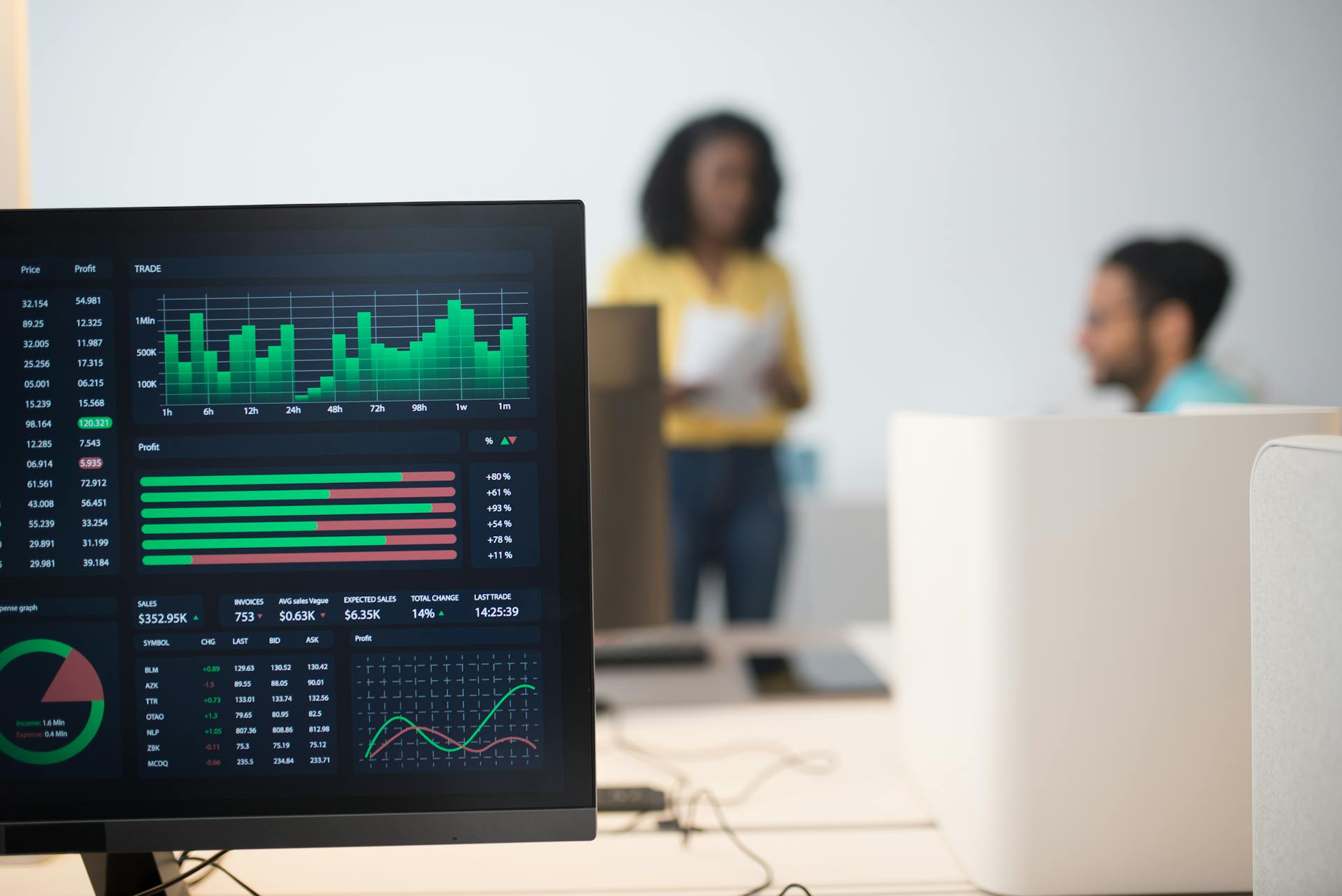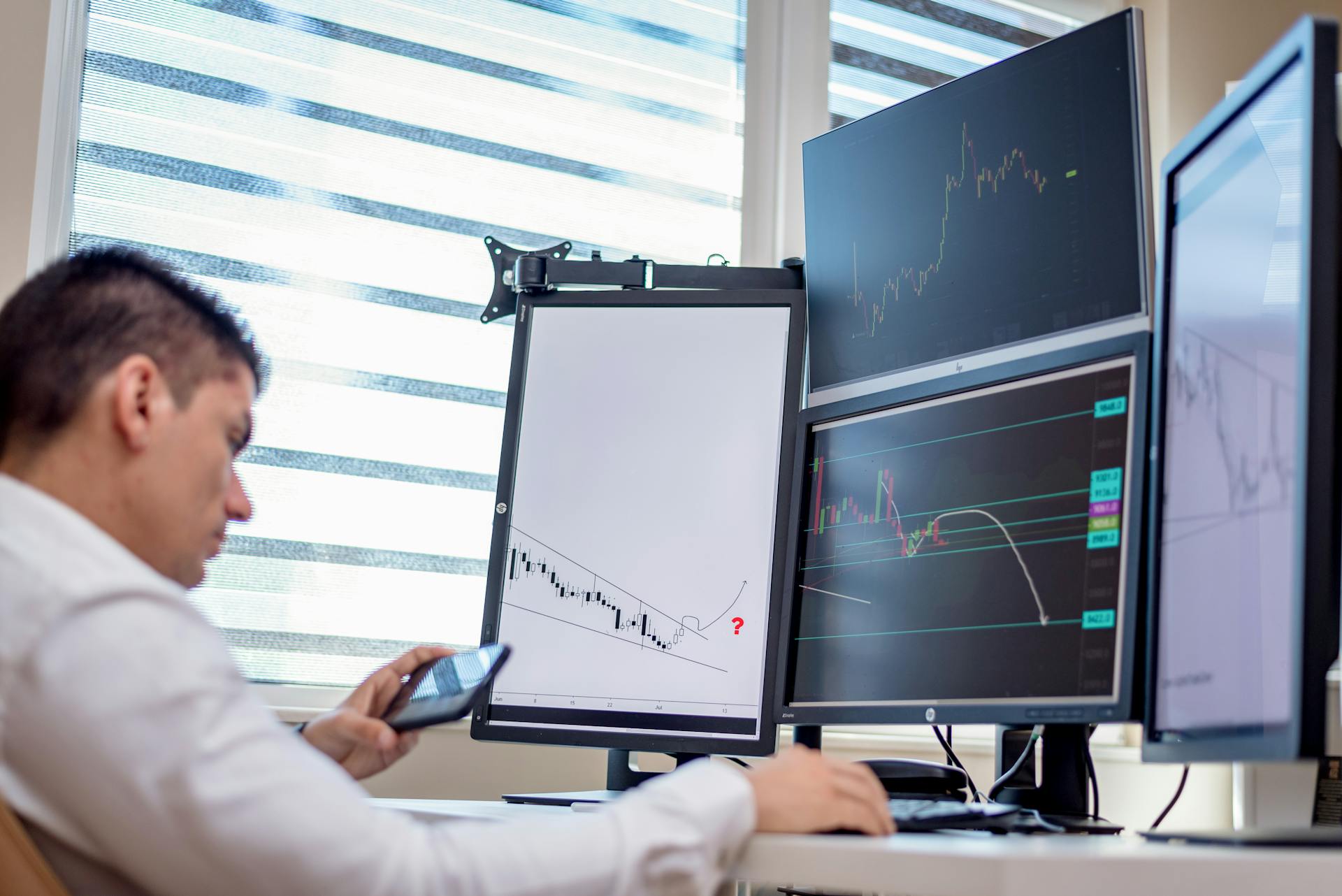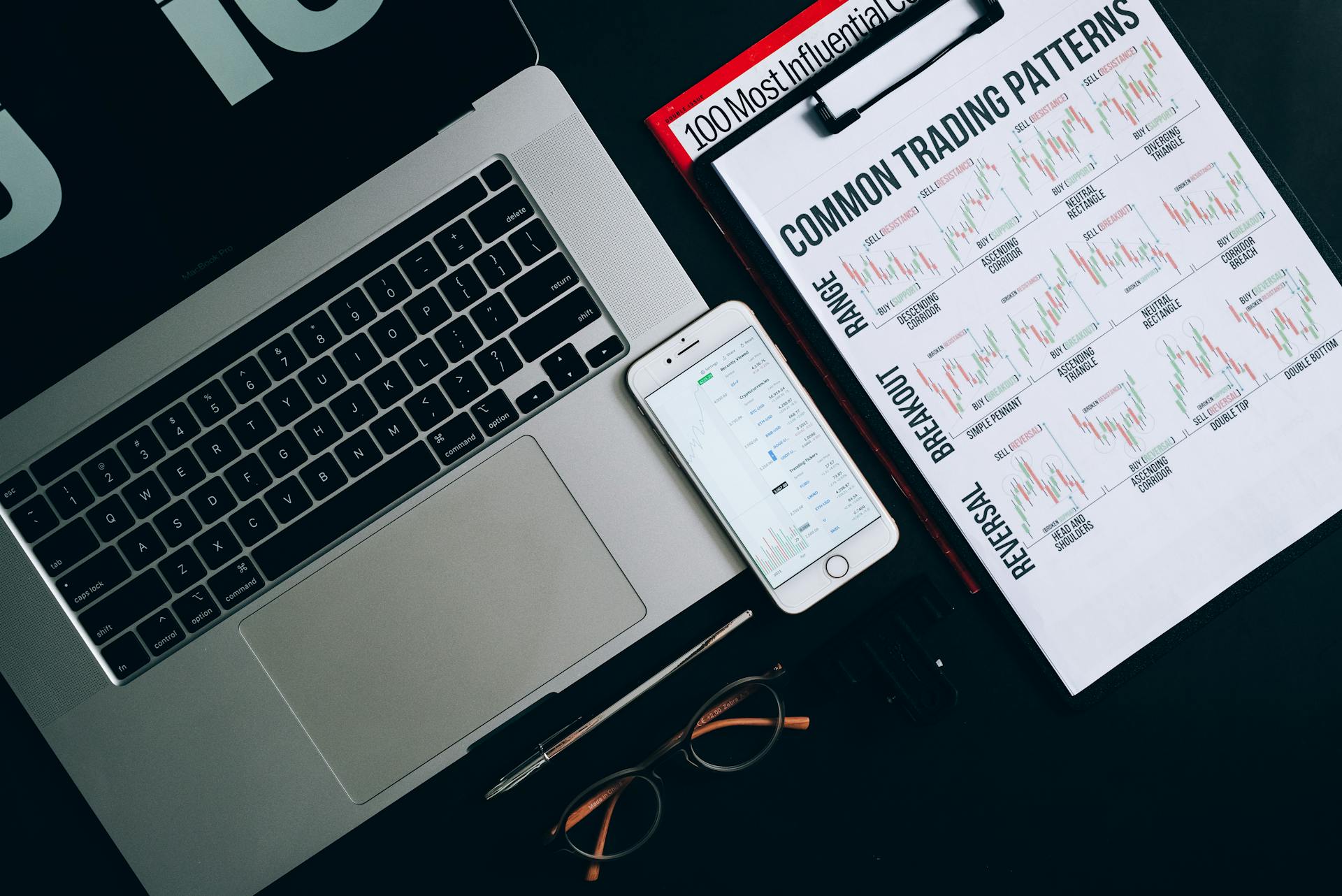
Algo trading strategy can be a game-changer for traders, offering the potential for high-frequency trading and reduced emotional decision-making.
This approach relies heavily on algorithms, which are pre-programmed sets of rules that generate buy and sell signals based on market data and other factors.
The benefits of algo trading are numerous, including the ability to process vast amounts of data quickly and make trades in fractions of a second.
One of the key advantages is the reduction of emotional decision-making, which can lead to impulsive and costly mistakes.
Algo trading strategies can be tailored to specific goals, such as maximizing returns or minimizing risk.
However, this approach also carries significant risks, including the potential for algorithmic errors and market volatility.
A well-designed algo trading strategy can help mitigate these risks, but it requires careful planning and execution.
Best practices for algo trading include thorough backtesting, risk management, and ongoing monitoring and adjustment.
What Is Algo Trading?
Algo trading, also known as algorithmic trading, is a computer-generated approach to executing market orders. It's based on predefined rules and instructions that take into account various parameters like stock price, timing, and quantity.
Algo trading involves using intricate formulas and mathematical tools to make trading decisions, but human oversight is still required to make the final decisions.
To develop an algo trading strategy, you need to identify a set of rules that a trading platform can follow without human intervention. For example, a simple algo trading strategy might be to "buy 100 shares of Apple whenever the 50-day moving average crosses above its 200-day moving average."
Algo trading strategies include signal generation, risk management, portfolio and order management, and execution. Here are the key components:
- Signal generation: This is the process of identifying possible trading opportunities based on quantitative or technical criteria.
- Risk management: Algo trading strategies don't necessarily dump all their capital into the first opportunity they see. Instead, positions are sized appropriately based on predefined risk criteria.
- Portfolio and order management: Following trade execution, the algo will monitor its performance and resize positions as needed.
- Execution: This final component is the actual trade order execution of the strategy.
By automating trading decisions, algo trading can facilitate rapid buy or sell order execution and potentially generate substantial profits compared to human trading.
Advantages and Disadvantages
Algorithmic trading offers numerous benefits, but it's not without its drawbacks. Modern computers can process vast amounts of data and rapidly execute trades, allowing for high-frequency trading strategies that capitalize on minor price discrepancies.
Emotions play a significant role in trading, often leading to biased decisions. Automated trading strategies operate without emotions, ensuring they don't suffer from psychological pitfalls like fear or greed.
Algorithms don't have bad days or commute to work, delivering consistent execution without deviation. This consistency is a major advantage of algo trading.
Backtesting is a valuable tool for algorithmic trading, enabling creators to tweak and refine their rules based on performance in a live market.
Algo trading's rapid execution capability leverages automated processes, allowing trades to be executed swiftly, capitalizing on advantageous market conditions. This speed is a major draw for both retail and institutional traders.
Algo trading removes emotional biases inherent in manual trading, as decisions are based on predefined rules, eliminating the impact of fear or greed on trading decisions. This emotional bias elimination is a significant advantage of algo trading.
Here are some key advantages and disadvantages of algorithmic trading:
Algo trading's adaptability to market changes enables strategies to adjust promptly to new trends or shifts in the market environment. This adaptability is a major advantage of algo trading.
Challenges and Concerns
High-frequency or large-volume trades can substantially impact the market if improperly designed, causing the price to drop as you exit, hurting profits.
Overfitting is a real concern in automated trading strategies, where a finely tuned approach looks great when backtesting but becomes ineffective with even a slight price shift.
Technological failures can drive significant losses, as reliance on technology means algorithms are at risk when they fail.
Regulators often heavily scrutinize automated trading strategies due to their potential for severe market disruption, generating a bad rap in the process.
Here are some specific challenges associated with algorithm trading:
- Market Impact and Slippage
- Overfitting
- Technological Failures
- Regulatory Scrutiny
Challenges and Concerns
Algorithmic trading is a complex and nuanced field that comes with its own set of challenges and concerns. Improperly designed high-frequency or large-volume trades can substantially impact the market, driving prices down and hurting profits.
Market impact and slippage are two major concerns that traders need to be aware of. Selling too many shares of a company relative to the outstanding quantity can drive the price down as you exit, leading to significant losses.
Overfitting is another issue that can render an automated trading strategy ineffective. If a strategy is too finely tuned to historical data, it may not perform well in changing market conditions.
Technological failures can also have a significant impact on trading. Glitches or unforeseen bugs can drive significant losses, making it essential to have robust systems in place.
Regulators are increasingly scrutinizing automated trading strategies due to concerns about market disruption. This can lead to increased costs and compliance burdens for traders.
Here are some common challenges associated with algorithmic trading:
- Market Impact and Slippage: Selling too many shares of a company relative to the outstanding quantity can drive the price down as you exit.
- Overfitting: An automated trading strategy that is too finely tuned to historical data may not perform well in changing market conditions.
- Technological Failures: Glitches or unforeseen bugs can drive significant losses.
- Regulatory Scrutiny: Automated trading strategies are subject to increased regulatory scrutiny due to concerns about market disruption.
Resource Insufficiency
Resource Insufficiency is a major challenge in algo trading. Inadequate resources can lead to algorithm failures, which can be costly and damaging to your reputation.
A well-equipped infrastructure is crucial for supporting the speed and complexity of high-frequency trading algorithms. This includes data storage, networking, and sufficient computing power.
Inadequate resources can cause algorithm failures, which can be unpredictable and difficult to troubleshoot. Successful algo trading requires careful planning and consideration of resource needs.
High-frequency trading strategies require a robust infrastructure to execute trades quickly and efficiently. Inadequate resources can lead to missed opportunities and lost profits.
Here's an interesting read: Street Smarts High Probability Short Term Trading Strategies
Building Blocks
Collecting a substantial volume of historical price data is essential for spotting price patterns that can guide your investment decisions. This data can be used to identify trends and make informed trading decisions.
Economic indicators like the wholesale price index, food price index, and real gross domestic product (Real GDP) can help you gauge the actual effect of geopolitical events on financial markets.
To develop a comprehensive trading algorithm, you'll need to define clear objectives, such as your risk tolerance, expected returns, and target markets or instruments. This will lay the groundwork for a focused and effective strategy.
Here are the essential steps to develop a profitable algorithmic trading strategy:
- Define Clear Objectives
- Conduct thorough research into the markets you intend to trade
- Develop a comprehensive trading strategy
- Backtest and optimise the strategy
- Implement robust risk management techniques
- Test the strategy in real-time or simulated environments
- Continuously monitor and improve the strategy
Building Blocks
Gathering market data is a crucial step in building a solid trading strategy. Analyzing extensive market data from reliable sources can help spot trends that can guide your investment decisions.
To collect valuable market data, you should start by charting price patterns, which is perhaps the most commonly used method of predicting future stock behavior. Collecting a substantial volume of historical price data can help you spot price patterns that can guide your investment decisions.
Broaden your view: Spot Algo Trading Software

Economic indicators like the wholesale price index, food price index, and real gross domestic product (Real GDP) can help you gauge the actual effect of geopolitical events like the Russia-Ukraine war on financial markets. No matter how stable, every business sector is tied to several variables like geopolitics, consumer trends, and global cultural events.
Data accuracy and adequacy are essential when developing AI-based models. Inaccurate or insufficient data can disrupt the strategy, resulting in unexpected transactions or significant losses.
To develop a profitable algorithmic trading strategy, traders should exercise caution in several areas to ensure robustness and efficacy. Over-optimisation, data mining bias, limitations of historical data, unforeseen market events, technological glitches, and maintaining awareness of these cautionary aspects can help traders develop more resilient and adaptable algo trading strategies.
Investors usually crunch several types of market data to gain valuable future investment insight. They include:
- Historical price data
- Economic indicators
- Geopolitical events
- Consumer trends
- Global cultural events
Position sizing is a crucial aspect of trading strategy development. The goal of position sizing is to allocate an optimal amount of capital to each trade, considering the potential profit and loss and aiming to maximize returns while managing risk.
Expand your knowledge: What Is Position Trading
Volume Weighted Average
The Volume Weighted Average is a powerful tool for traders and investors. It provides an average price of a security that accounts for both the price as well as the volume traded throughout a trading day.
This concept is often used by institutional traders to help ensure they aren’t paying too much or receiving too little on a sale. The VWAP is calculated by assigning a higher weight to the price at times with higher volume.
The VWAP can be used to identify whether a security is overpriced or undervalued. If the price of a security is above the VWAP, it may indicate a good buy at a value price. Conversely, it might be considered overpriced when the price is below the VWAP.
The VWAP strategy breaks down large orders into smaller chunks based on historical volume profiles. Its objective is to execute orders as close as possible to the volume-weighted average price (VWAP).
Here are some key characteristics of the VWAP strategy:
- Concept: The VWAP provides an average price of a security that accounts for both the price as well as the volume traded throughout a trading day.
- Strategy: VWAP is commonly used by institutional traders to help ensure they aren’t paying too much or receiving too little on a sale.
- Objective: Execute orders as close as possible to the volume-weighted average price (VWAP).
Stochastic Oscillator
The stochastic oscillator is a method that compares a stock's close price to its historical price range over a specified period.
It's a useful tool for analyzing market trends, and it's often used in conjunction with other indicators to make informed trading decisions.
The oscillator processes values that lie between 0 and 100, which can help traders identify potential buying and selling opportunities.
A 14-day period is commonly used as part of the assessment, but traders can adjust this timeframe to suit their needs.
This method can be particularly useful for identifying overbought and oversold conditions in the market.
Here are some key points to keep in mind when using the stochastic oscillator:
- Values between 0 and 20 indicate oversold conditions.
- Values between 80 and 100 indicate overbought conditions.
- A 14-day period is commonly used as part of the assessment.
Arbitrage
Arbitrage is a trading strategy that involves taking advantage of price differences between related securities. It's a way to profit from temporary mispricings in the market.
The arbitrage strategy typically involves identifying price differences between dual-listed securities or securities traded on different exchanges. This can be done using algorithms that automatically execute high-speed trades to exploit these opportunities.
Arbitrage opportunities can disappear quickly, so speed is key in this strategy. A slow computer can mean missing out on a profitable trade.
Here are some common types of arbitrage:
- Statistical Arbitrage: Exploits minor price deviations from the mean using quantitative models.
- Dual-listed security arbitrage: Takes advantage of price differences between securities listed on different exchanges.
- Futures market arbitrage: Exploits price differences between securities traded on the futures market.
In practice, arbitrage involves buying a security at a low price and selling it at a higher price on another exchange. This can be done automatically using algorithms that execute trades in real-time.
The risk in arbitrage is that the computer may be slow in executing the second leg of the trade, missing out on the opportunity to profit from the price difference.
Mathematical Model Based
Building a strong foundation in mathematical models is crucial for making informed investment decisions. Collecting a substantial volume of historical price data can help you spot price patterns that can guide your investment decisions.
Economic indicators like the wholesale price index, food price index, and real gross domestic product (Real GDP) can help you gauge the actual effect of geopolitical events like the Russia-Ukraine war on financial markets.
Statistical arbitrage, or StatArb, uses quantitative models to exploit minor price deviations from the mean. This strategy relies on statistical analysis and mathematical models to identify instances where the price of one asset seems to deviate from its historical relationship with another asset.
Mathematical models, such as delta-neutral, play a vital role in this strategy, allowing for trading involving options and underlying securities. Delta-neutral strategies comprise positions that offset positive and negative deltas, with delta representing the asset's price change relative to its derivative.
To develop a comprehensive trading algorithm, you need to know which trends you'd like to target. This will help you create a strategy that exploits perceived mispricing of related securities.
Here's a breakdown of the key components of a delta-neutral strategy:
By combining these positions, you can create a delta-neutral strategy that offsets positive and negative deltas. This can help you make informed investment decisions and potentially generate returns on your stock investments.
Intermediate Strategies
As you progress in your algo trading journey, it's essential to consider intermediate strategies that can elevate your trading game. Adding sophistication to your approach can make a significant difference in your results.
To hone your coding skills, you can start by practicing with bonus exercises or taking online courses that focus on programming languages like Python or R. This will help you develop the expertise needed to implement more complex trading strategies.
By incorporating intermediate strategies, you can refine your trading approach and achieve better outcomes.
Intermediate Strategies
As an intermediate learner, you're likely looking to take your skills to the next level. To do this, you'll need to start thinking about more advanced strategies.
Adding sophistication to your skills is a key part of becoming an expert. This can be achieved by honing your coding skills.
Practicing and refining your coding skills will help you to tackle more complex problems and projects. It's a crucial step in becoming a proficient developer.
Key Strategies
Algorithmic trading strategies are all about using computers to execute trades quickly and efficiently. This allows for high-frequency trading strategies that can capitalize on minor price discrepancies.
One of the first trading strategies adopted by algo traders was arbitrage, where they would buy a stock from one exchange and sell it on another where the price was lower. This strategy is still used today.
Arbitrage opportunities can be found by comparing prices on different exchanges. The computer can keep checking prices and execute the trade the moment it sees an opportunity.
Algorithmic trading programs in India start with identifying opportunities that can yield improved earnings or cost reductions. Each trading strategy is built upon recognizing such opportunities.
To deliver consistent execution without deviation, algorithms don't show up to work in a bad mood. They operate without emotions, ensuring they don't suffer from psychological pitfalls like fear or greed.
Algorithms can backtest to help understand how they would have performed in a live market. This enables their creators to tweak and refine the rules based on the feedback.
Here are some common algo trading strategies:
- Arbitrage: buying a stock from one exchange and selling it on another where the price is lower
- High-frequency trading: executing trades rapidly to capitalize on minor price discrepancies
- Backtesting: using historical data to refine and improve trading strategies
Tools and Software
To get started with algorithmic trading, you'll need the right tools. Skillshare is an excellent educational hub that offers courses on coding, including Coding 101: Python for Beginners, which guides you from the basics to more advanced coding strategies.
TradeStation is one of the best platforms for implementing complex and profitable algorithms, with hundreds of customizable apps and competitive commissions. It also offers access to a vast library of educational materials and research.
For backtesting and advanced visualizations, Finviz is a top choice, offering a vast set of tools, including backtesting that can recognize 102 unique chart patterns up to two years back using multiple combinations, 67 stock screening metrics, and integrated news aggregation.
Tools and Software
To get started with algorithmic trading, you'll need the right tools. Skillshare is an excellent educational hub with courses on coding, including Coding 101: Python for Beginners, which guides you from the basics to more advanced coding strategies.

Skillshare's courses are perfect for beginners, but if you're looking for a more advanced platform, TradeStation is a top pick. With over three decades in the market, TradeStation has a strong reputation and offers hundreds of customizable apps for advanced traders with coding experience.
TradeStation's tools are suitable for a wide range of traders, and it offers competitive commissions and access to a vast library of educational materials and research. If you're new to coding, understanding the basics is crucial for success in algo trading.
For backtesting and advanced visualizations, Finviz is the way to go. Finviz Pro offers a vast set of tools, including backtesting that can recognize 102 unique chart patterns up to two years back using multiple combinations.
Here are some key features of Finviz Pro:
- Backtesting that can recognize 102 unique chart patterns up to two years back using multiple combinations.
- 67 stock screening metrics.
- Integrated news aggregation.
- Fast heatmaps that provide valuable sector and industry visualizations.
For building, testing, and deploying trading strategies, Tradetron is a great option. Tradetron's easy-to-use strategy builder allows every trader to build, customize, and optimize trading strategies down to the finest details.
Tradetron's live testing and backtesting modules further allow traders to regularly check their algorithms and monitor their efficiency. Ultimately, the right tool for you will depend on your specific needs and preferences.
Radical X13 Computer
The Radical X13 Computer is a powerhouse for algo trading. It's equipped with a liquid-cooled Intel Core i9-13900KF 24 CORE Processor that can reach speeds of up to 5.8 Ghz in Turbo Boost Mode.
This computer is designed to handle demanding tasks with ease, making it an excellent choice for traders who need a reliable and fast system.
Here are some key specs to consider:
- Processor: Liquid-cooled Intel Core i9-13900KF 24 CORE Processor
- RAM: Option to include 64 GB
- Storage: Available 1 TB solid state drive (SSD)
- Display: Ability to display up to 4 monitors
With its impressive specs and features, it's no wonder the Radical X13 Computer comes with a 5-year warranty and lifetime tech support.
News Data
News data is a crucial source of market information that informs traders of various events affecting share prices. This data can be highly unstructured, but it's still a vital component of any trading strategy.
News data can be sourced from various places, but one of the most reliable sources is Seeking Alpha, which crowdsources investment research from over 16,000 contributors. These contributors are required to disclose their portfolio holdings, making it an invaluable resource for investment due diligence.
To get a feel for news that can move stocks, it's essential to understand that news events can significantly impact markets and security prices. For example, an announcement from the Federal Reserve about interest rate tightening can send stock prices lower.
News data can be used to identify potential trading opportunities, such as news trading algorithmic strategies that aim to capitalize on market movements resulting from major news events. These systems can rapidly place trades to profit from the event, relying heavily on powerful computers that can parse events and execute trades quickly.
Here are some key types of news events that can move stock prices:
- Federal Reserve announcements
- Company earnings reports
- Merger and acquisition announcements
- Government policy changes
Frequently Asked Questions
What is the best strategy for algo trading?
There is no single "best" strategy for algo trading, as the most effective approach often depends on market conditions and trading goals. However, trend-following and mean reversion strategies are popular and widely used in algorithmic trading, offering opportunities for profitable trades in various market scenarios.
Is algo trading really profitable?
Yes, algorithmic trading can be profitable, offering a systematic approach to trading that can help traders execute trades more efficiently. With the right strategy and execution, algo trading can provide a competitive edge in the market.
What is the best day trading algorithm?
There is no single "best" day trading algorithm, as the most effective approach often depends on market conditions and individual trading goals. However, popular strategies like Mean Reversion and Statistical Arbitrage have shown promising results in various market environments.
What is the most successful algo trading strategy?
The most successful algo trading strategy is the Weighted Average Price (WAP) strategy, which uses sales volume or time to determine optimal entry and exit points. This strategy is considered one of the best due to its ability to adapt to changing market conditions.
Sources
- https://www.wallstreetzen.com/blog/algorithmic-trading-strategies/
- https://www.5paisa.com/blog/algorithmic-trading-strategies
- https://tradetron.tech/blog/how-to-build-a-bullet-proof-algo-trading-strategy
- https://www.smallcase.com/learn/what-is-algo-trading/
- https://www.utradealgos.com/blog/7-essential-steps-to-develop-a-profitable-algorithmic-trading-strategy
Featured Images: pexels.com


